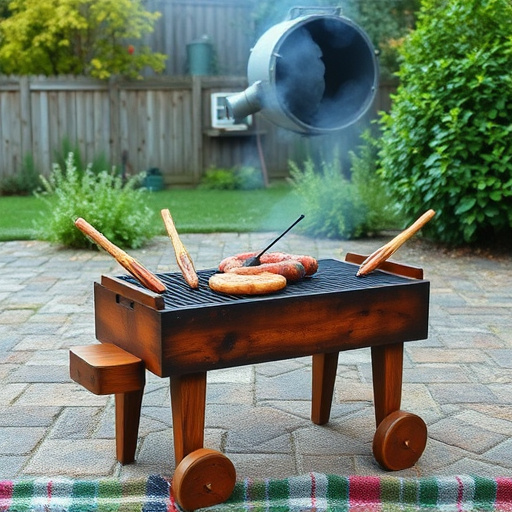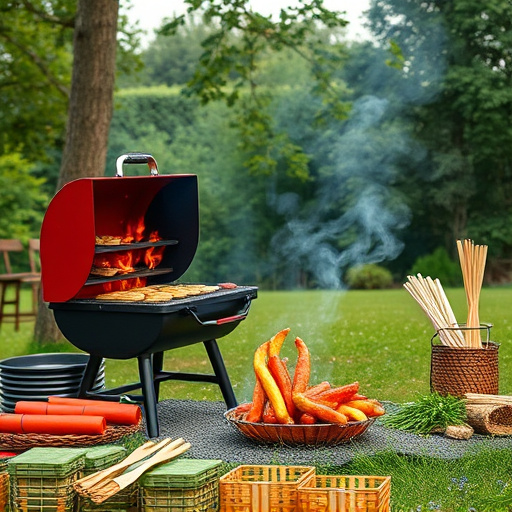Selecting the right cut of beef is essential for making a superior BBQ beef jerky at home. Opt for lean, well-marbled cuts like sirloin or round steak with minimal fat (at least 20%) to ensure crispness and intense flavor. Use a flavorful marinade with soy sauce, vinegar, brown sugar, and spices, marinate for 4 hours to overnight, then bake until dry. Slice thinly against the grain for optimal texture and enjoy a healthier, homemade BBQ jerky snack.
Looking for a healthy homemade BBQ beef jerky snack? This comprehensive guide provides all you need to create a delicious, nutritious treat. From selecting the best cut of lean beef for maximum flavor and minimal fat to mastering the perfect marinade, achieving the ideal texture, and exploring creative serving suggestions, we’ve got you covered with this step-by-step BBQ beef jerky recipe. Discover how to make your own tasty jerky without compromising on quality or safety.
- Choosing the Best Cut of Beef for Jerky
- – Discussing the ideal cut of beef for making jerky at home
- – Benefits of using lean meat for a healthier option
- The Perfect Marinade for Flavorful BBQ Jerky
- – Essential ingredients for a homemade BBQ marinade
Choosing the Best Cut of Beef for Jerky

When crafting a BBQ beef jerky snack at home, selecting the perfect cut of meat is a crucial step in achieving the best possible result. Opting for a lean yet flavorful cut ensures your final product will be both tender and packed with delicious BBQ flavors. The ideal choice is often a combination of various muscle groups, like cross-cut from the chuck or brisket, ensuring a good balance between tenderness and chewing satisfaction. These cuts are typically lower in fat, which is essential for jerky as excess fat can make the meat greasy and less crispy.
For a mouthwatering BBQ beef jerky recipe, look for cuts with visible marbling—the streaks of fat within the muscle. This adds flavor and moisture to your jerky. Remember, the goal is to end up with a tender, satisfying snack that highlights the original taste of the meat enhanced by your BBQ spices. The right cut will make all the difference in the final product’s quality and appeal.
– Discussing the ideal cut of beef for making jerky at home

When making BBQ beef jerky at home, choosing the right cut of meat is key to achieving that perfect, chewy texture and intense flavor. The ideal cut for jerky is lean, well-marbled beef with a good balance of fat and muscle fibers. Look for cuts like round steak, sirloin tip roast, or even flank steak. These cuts tend to be less fatty than others, ensuring your jerky stays crisp and doesn’t become soggy. A leaner cut will also result in a more concentrated flavor, allowing the BBQ spices to shine through.
A good rule of thumb is to opt for a cut with at least 20% fat content. This helps keep the meat moist during the drying process, preventing it from becoming brittle or tough. Additionally, these cuts are often more affordable than prime steak options, making homemade BBQ beef jerky an economical and delicious snack idea.
– Benefits of using lean meat for a healthier option

Using lean meat is a fantastic way to make your homemade BBQ beef jerky recipe healthier and more nutritious. Traditional beef jerky often contains high levels of fat, but by opting for cuts like sirloin or round steak, you can significantly reduce this. Lean meat provides a great source of protein, which is essential for muscle health and repair, without the excess calories and saturated fats found in fatter cuts. This healthier option not only makes your snack more diet-friendly but also ensures you’re getting the most out of your ingredients.
This approach allows you to enjoy the classic BBQ jerky taste while incorporating a balanced nutritional profile. Lean meat is versatile and, when combined with a well-crafted seasoning blend, can create a delicious, crunchy snack that caters to various dietary preferences and health goals. So, whether you’re an athlete looking for a post-workout treat or simply trying to make healthier choices, this simple switch in your BBQ beef jerky recipe will surely benefit your overall well-being.
The Perfect Marinade for Flavorful BBQ Jerky

Creating the perfect BBQ beef jerky at home starts with a flavorful marinade. For an authentic and mouthwatering BBQ beef jerky recipe, combine 1/4 cup each of soy sauce, apple cider vinegar, and brown sugar, along with 2 tablespoons of olive oil, 1 tablespoon of Worcestershire sauce, 2 cloves of minced garlic, and 1 teaspoon each of dried oregano and peppercorns. This well-balanced blend infuses the meat with a rich, smoky flavor that’s hard to beat.
The key to successful jerky is not just about the marinade; it’s also about the quality of your beef. Opt for lean cuts like sirloin or round steak, trimming any visible fat. After marinating for at least 4 hours—or overnight for even deeper flavors—preheat your oven to a low temperature (around 200°F or 93°C) and bake the meat until it’s almost completely dry. This step is crucial in ensuring your jerky isn’t slimy when you bite into it. Once cooked, let the meat cool before slicing it thinly against the grain for the best texture and maximum flavor.
– Essential ingredients for a homemade BBQ marinade

Creating your own BBQ beef jerky at home is an excellent way to control ingredients and enjoy a healthier alternative to store-bought options. The foundation of any delicious BBQ beef jerky recipe lies in its marinade. Key essential ingredients for a homemade BBQ marinade include high-quality lean beef (such as sirloin or flank steak), a good quality BBQ sauce, vinegar (like apple cider or white vinegar) for tenderness, and a blend of spices like garlic powder, onion powder, salt, pepper, and paprika to add depth of flavor.
Don’t forget the sugar or honey, which not only sweetens the marinade but also helps caramelize and give your jerky that distinctive BBQ glaze. A small amount of liquid smoke can be added for an authentic smoky flavor, though it’s optional. Ensure your beef is cut into thin slices to allow the marinade to penetrate and tenderize the meat effectively during the drying process.
